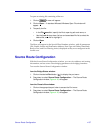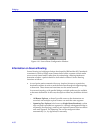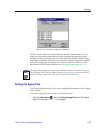
Source Route Configuration 4-59
Bridging
¥ When a source routing bridge processes the explorer frame, it adds a unique
identiÞer to the frame in a reserved portion of the frame. This identiÞes the
segment the frame was received from, followed by the speciÞc bridge, and
Þnally the segment it was forwarded onto.
¥ When the discovery frame (or frames if more than one route is possible)
reaches its destination, it contains a complete record of bridge hops on its
route.
¥ The destination address then returns All Routes Explorer (using speciÞcally
routed frames) and Single Route (spanning tree) Explorer frames (using All
Routes Broadcast frames), to the source address.
¥ The source station selects one path from the returned explorer frames, and
includes that path speciÞcation (with bridge and segment identiÞers) in
subsequent transmissions to that particular destination.
All bridges in the topology then examine the routing information Þeld of a
speciÞcally source routed frame and either forward it if there is a match in the
routing informationÑor if it is an All Routes explorer frameÑor discard it.
The Source Route Configuration Window
The Source Route ConÞguration window allows you to view IP address and
routing information, and to view and set source route bridging parameters for
any bridging device which supports this menu option.
Source Route Configuration Fields
IP Address
This Þeld displays the Internet Protocol (IP) address, which acts as a logical
identiÞer on the network, currently assigned to each port on the device. This is
needed for SNMP network management capability. The IP address is expressed in
dotted decimal notation (four decimal values between 0 and 255, separated by a
period, e.g., 255.255.255.255).
This Þeld can only be edited (with the correct security access) via Local
Management for the device (or the MIBTools utility). Refer to the appropriate
device-speciÞc UserÕs Guide for more information.
NOTE
It is recommended that the device be restarted when changes are made that affect source
route bridging in order to clear the buffers, but you do not need to restart for the changes
to take effect.


















